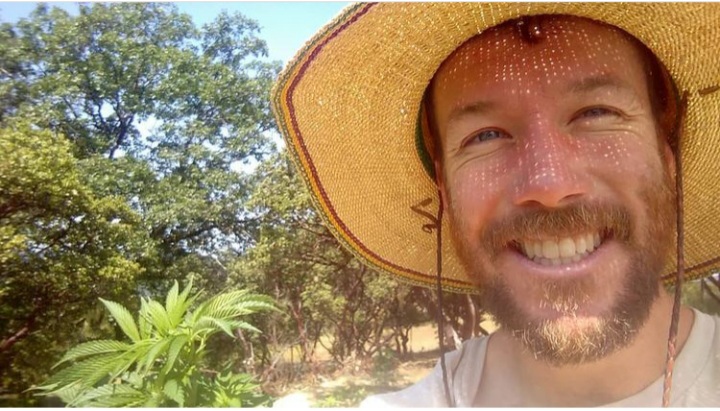HappyDay: ‘Succession Planting is the Key to Our Small Farm’
Casey O’Neill is a cannabis and food farmer in Mendocino County who has been writing newsletters about his efforts to provide sustainable produce and marijuana. We feature his column once a week.

Yesterday we were laying out drip irrigation in the heat, sweat dripping in my eyes. Today dawned cool and wet, a gentle spring rain that allowed me to shut off the water systems and spend some time taking stock of the situation. It’s a good day for cleaning and organizing, for getting ready for the week to come.
In the next few days we’ll plant out the bulk of the outdoor cannabis, clones that have been vegging in the greenhouse awaiting the longest days of the year. The seed start cannabis plants have been out for a bit and are loving the moisture, leaves glistening and moving gently with the raindrops.
The weeds are tall and we’ve been working hard to pull them, cut them, and keep them in check so that they don’t go to seed or overtake the crops with which they compete. The effort doubles as production of forage for pigs, chickens and rabbits. The big tubs and totes full of plants that we pull out of the beds make for a varied and nutritious diet that supplements the grain and other store-bought feed sources.
Succession planting is the key to our small farm, rotating through crops a small block at a time over the course of the season. A farmer friend from Oregon once told me “we plant as much as we think we can sell each week”. This serves as a rough guideline for us, with many small plantings of a wide variety of crops over the course of the season.
Once you set the rotations in motion they take on an inertia that provides a consonance to life, like the bass drum setting the rhythm. Prep the beds, sow the seeds, irrigate, tend, weed and fertilize. Cage or trellis the crops that need it. Harvest, clear the bed and begin the journey again.
Water is the lifeblood of the farm. Last year was so dry that we ceased succession planting about now, riding out the crops that we had in the ground and fallowing beds to await the rains. This year with the late spring rains, the pond is nearly full and we are sowing extra rounds of winter squash, pumpkins and melons.
I’ve been very pleased to find how much our pigs love all types of squash, from butternuts to pumpkins to monster zucchinis. Everyone loves melons so it’s no surprise that they’re a pig favorite, but there is little better in farm life than watching pigs eat a melon, slurping and snorfling and wiggling their tails in delight.
August is the only time to lock your car around here because you might come out of the grocery store to find a box of zucchinis on your passenger seat. Pigs change that, so that I welcome any and all additions of monster squash, along with apple drops, funky fruit and other orchard and garden wastes.
Right now cabbage leaves and stems are a main staple for livestock on the farm; they love the sweet crunchiness and I love being able to make use of the non salable parts in ways that justifies the large space each plant takes up in the garden. Brassica are a hit now, soon it will be cannabis leaves and comfrey, then squashes, cukes and melons, then cover crop harvested as forage and then back to brassica. The cycle continues.
In an ideal water year with enough mental and physical capacity, we’ll start seeds every week except for the two weeks around the summer and winter solstices. We’re about to wind down the summer crop plantings for the year, and then as we get into July we’ll begin fall brassica plantings. Salad mixes, root crops, scallions, cilantro, basil and other small, space-fillers will continue through the summer, as will second sowings of beans and cucumbers.
There are a number of benefits to multiple sowings spaced out over a few weeks. It takes less work and I need less space available for each planting. This means that plants go out faster and rarely languish in the greenhouse (as often happens with big plantings), and there is less likely to be broad crop failure because each succession has a different set of weather and pest parameters. The harvests are staggered, so there is less likely to be waste from overproduction. Succession planting takes more coordination and planning, but with practice it works well. As always, much love and great success to you on your journey!

Join the discussion! For rules visit: https://kymkemp.com/commenting-rules
Comments system how-to: https://wpdiscuz.com/community/postid/10599/
From US cannabis spot index, June 10, 2022
“California spot lost $22 this week with outdoor-grown cannabis still under pressure in the mid-to-low $400s, a new record low for the most abundant outdoor stock in the nation.“
https://www.cannabisbenchmarks.com/report-category/united-states/
Central valley gonna be selling dope for 60 bucks a pound soon.and Stull be able to make it profitable. I would never purchase weed produced in the emerald triangle , because of my experience with the terrible selfish scumbags,
Many central valley communities can’t produce any marketable product outside a strictly controlled environment due to pesticide contamination in their air and water. Even in states like Oklahoma where there is minimal regulation people can’t produce quality flower for that cheap.